Primary Health Care in China
VerifiedAdded on 2022/10/31
|10
|2389
|202
AI Summary
This article discusses the efforts made by China to distribute healthcare facilities evenly across the country to overcome inequalities that infringe on health distribution. It also talks about the most common non-communicable diseases in China and the efforts made to fight them. The article also highlights the role of nurses in promoting quality healthcare and the importance of cultural competence in dealing with non-communicable diseases.
Contribute Materials
Your contribution can guide someone’s learning journey. Share your
documents today.

Running head: HEALTH CARE
1
Primary Health Care in China
Student’s Name
Institution
Date
1
Primary Health Care in China
Student’s Name
Institution
Date
Secure Best Marks with AI Grader
Need help grading? Try our AI Grader for instant feedback on your assignments.
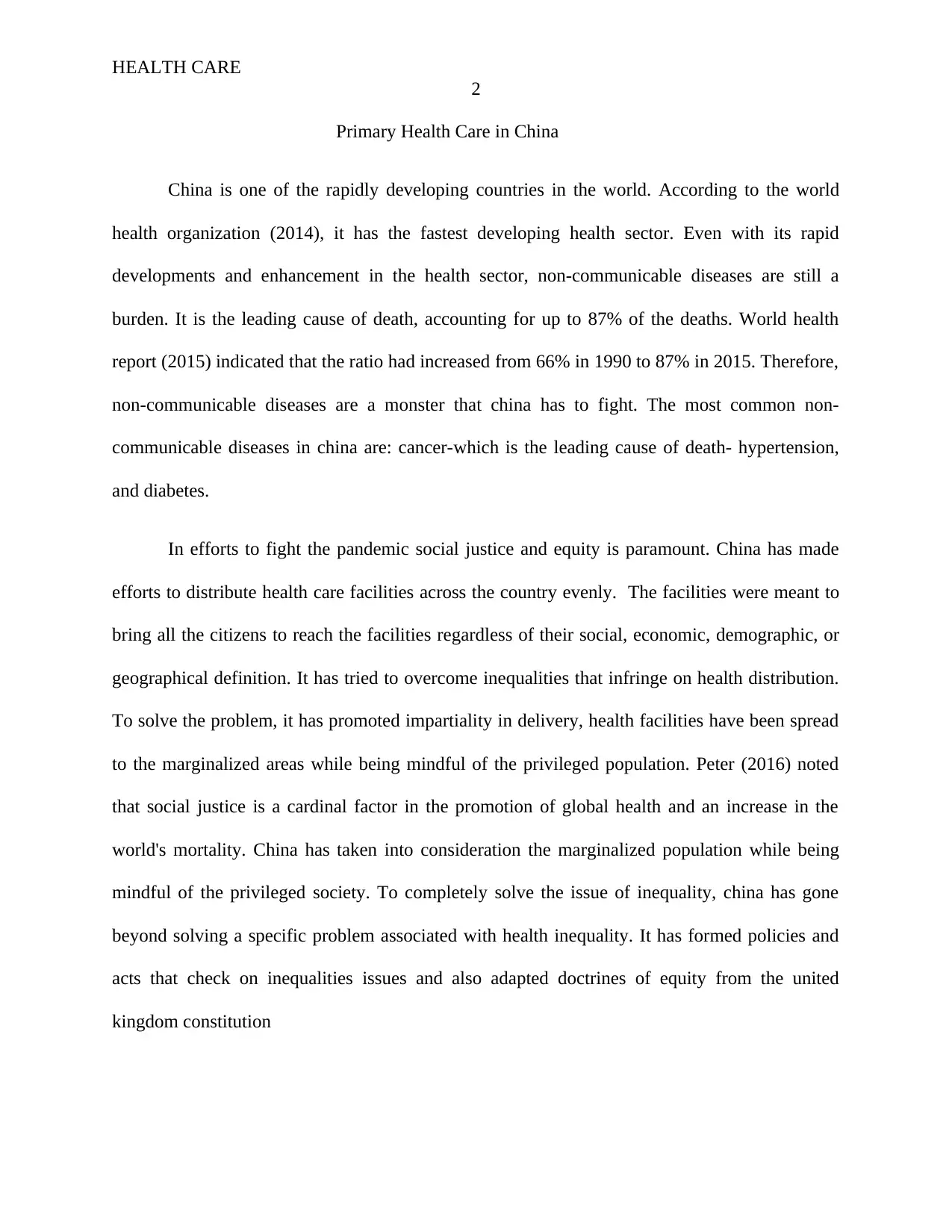
HEALTH CARE
2
Primary Health Care in China
China is one of the rapidly developing countries in the world. According to the world
health organization (2014), it has the fastest developing health sector. Even with its rapid
developments and enhancement in the health sector, non-communicable diseases are still a
burden. It is the leading cause of death, accounting for up to 87% of the deaths. World health
report (2015) indicated that the ratio had increased from 66% in 1990 to 87% in 2015. Therefore,
non-communicable diseases are a monster that china has to fight. The most common non-
communicable diseases in china are: cancer-which is the leading cause of death- hypertension,
and diabetes.
In efforts to fight the pandemic social justice and equity is paramount. China has made
efforts to distribute health care facilities across the country evenly. The facilities were meant to
bring all the citizens to reach the facilities regardless of their social, economic, demographic, or
geographical definition. It has tried to overcome inequalities that infringe on health distribution.
To solve the problem, it has promoted impartiality in delivery, health facilities have been spread
to the marginalized areas while being mindful of the privileged population. Peter (2016) noted
that social justice is a cardinal factor in the promotion of global health and an increase in the
world's mortality. China has taken into consideration the marginalized population while being
mindful of the privileged society. To completely solve the issue of inequality, china has gone
beyond solving a specific problem associated with health inequality. It has formed policies and
acts that check on inequalities issues and also adapted doctrines of equity from the united
kingdom constitution
2
Primary Health Care in China
China is one of the rapidly developing countries in the world. According to the world
health organization (2014), it has the fastest developing health sector. Even with its rapid
developments and enhancement in the health sector, non-communicable diseases are still a
burden. It is the leading cause of death, accounting for up to 87% of the deaths. World health
report (2015) indicated that the ratio had increased from 66% in 1990 to 87% in 2015. Therefore,
non-communicable diseases are a monster that china has to fight. The most common non-
communicable diseases in china are: cancer-which is the leading cause of death- hypertension,
and diabetes.
In efforts to fight the pandemic social justice and equity is paramount. China has made
efforts to distribute health care facilities across the country evenly. The facilities were meant to
bring all the citizens to reach the facilities regardless of their social, economic, demographic, or
geographical definition. It has tried to overcome inequalities that infringe on health distribution.
To solve the problem, it has promoted impartiality in delivery, health facilities have been spread
to the marginalized areas while being mindful of the privileged population. Peter (2016) noted
that social justice is a cardinal factor in the promotion of global health and an increase in the
world's mortality. China has taken into consideration the marginalized population while being
mindful of the privileged society. To completely solve the issue of inequality, china has gone
beyond solving a specific problem associated with health inequality. It has formed policies and
acts that check on inequalities issues and also adapted doctrines of equity from the united
kingdom constitution
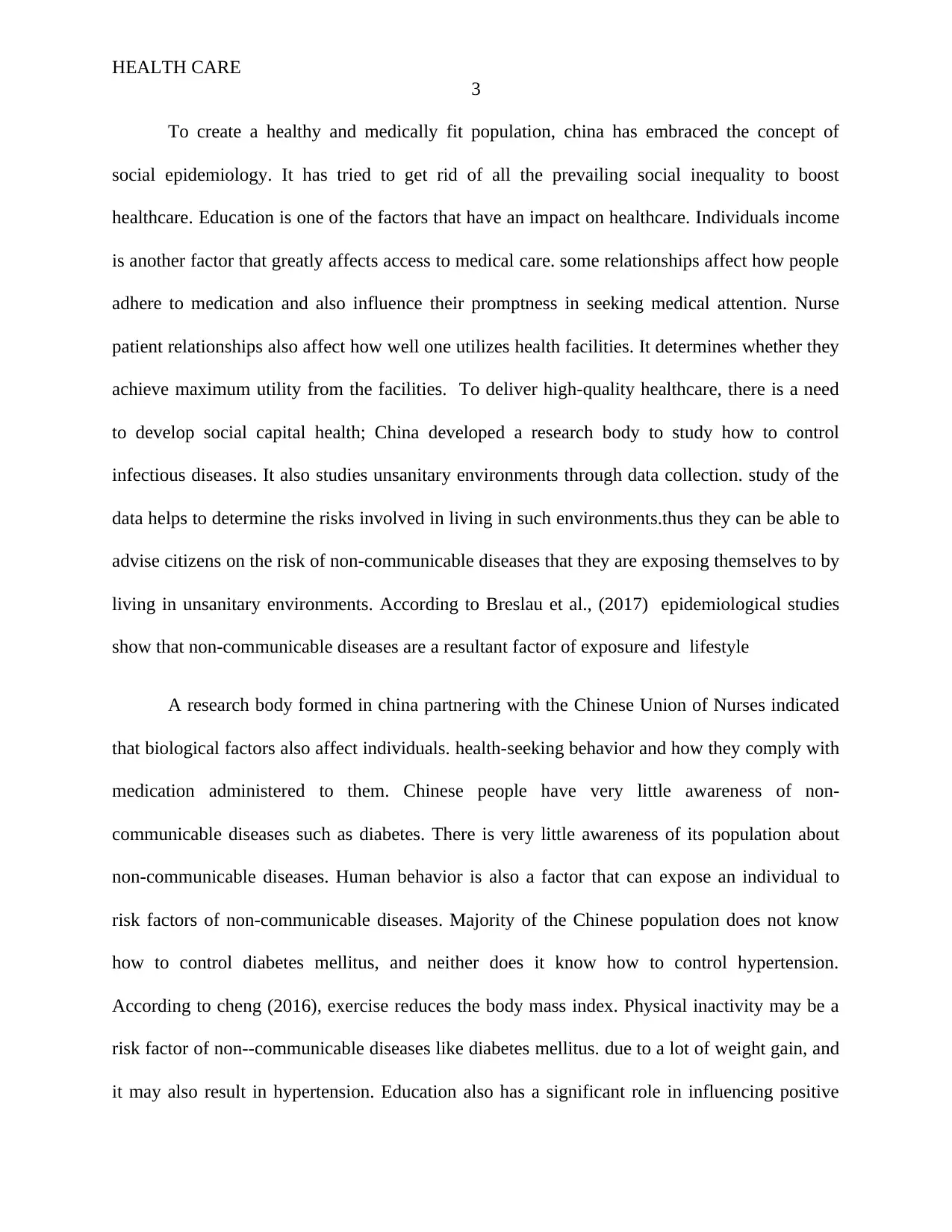
HEALTH CARE
3
To create a healthy and medically fit population, china has embraced the concept of
social epidemiology. It has tried to get rid of all the prevailing social inequality to boost
healthcare. Education is one of the factors that have an impact on healthcare. Individuals income
is another factor that greatly affects access to medical care. some relationships affect how people
adhere to medication and also influence their promptness in seeking medical attention. Nurse
patient relationships also affect how well one utilizes health facilities. It determines whether they
achieve maximum utility from the facilities. To deliver high-quality healthcare, there is a need
to develop social capital health; China developed a research body to study how to control
infectious diseases. It also studies unsanitary environments through data collection. study of the
data helps to determine the risks involved in living in such environments.thus they can be able to
advise citizens on the risk of non-communicable diseases that they are exposing themselves to by
living in unsanitary environments. According to Breslau et al., (2017) epidemiological studies
show that non-communicable diseases are a resultant factor of exposure and lifestyle
A research body formed in china partnering with the Chinese Union of Nurses indicated
that biological factors also affect individuals. health-seeking behavior and how they comply with
medication administered to them. Chinese people have very little awareness of non-
communicable diseases such as diabetes. There is very little awareness of its population about
non-communicable diseases. Human behavior is also a factor that can expose an individual to
risk factors of non-communicable diseases. Majority of the Chinese population does not know
how to control diabetes mellitus, and neither does it know how to control hypertension.
According to cheng (2016), exercise reduces the body mass index. Physical inactivity may be a
risk factor of non--communicable diseases like diabetes mellitus. due to a lot of weight gain, and
it may also result in hypertension. Education also has a significant role in influencing positive
3
To create a healthy and medically fit population, china has embraced the concept of
social epidemiology. It has tried to get rid of all the prevailing social inequality to boost
healthcare. Education is one of the factors that have an impact on healthcare. Individuals income
is another factor that greatly affects access to medical care. some relationships affect how people
adhere to medication and also influence their promptness in seeking medical attention. Nurse
patient relationships also affect how well one utilizes health facilities. It determines whether they
achieve maximum utility from the facilities. To deliver high-quality healthcare, there is a need
to develop social capital health; China developed a research body to study how to control
infectious diseases. It also studies unsanitary environments through data collection. study of the
data helps to determine the risks involved in living in such environments.thus they can be able to
advise citizens on the risk of non-communicable diseases that they are exposing themselves to by
living in unsanitary environments. According to Breslau et al., (2017) epidemiological studies
show that non-communicable diseases are a resultant factor of exposure and lifestyle
A research body formed in china partnering with the Chinese Union of Nurses indicated
that biological factors also affect individuals. health-seeking behavior and how they comply with
medication administered to them. Chinese people have very little awareness of non-
communicable diseases such as diabetes. There is very little awareness of its population about
non-communicable diseases. Human behavior is also a factor that can expose an individual to
risk factors of non-communicable diseases. Majority of the Chinese population does not know
how to control diabetes mellitus, and neither does it know how to control hypertension.
According to cheng (2016), exercise reduces the body mass index. Physical inactivity may be a
risk factor of non--communicable diseases like diabetes mellitus. due to a lot of weight gain, and
it may also result in hypertension. Education also has a significant role in influencing positive
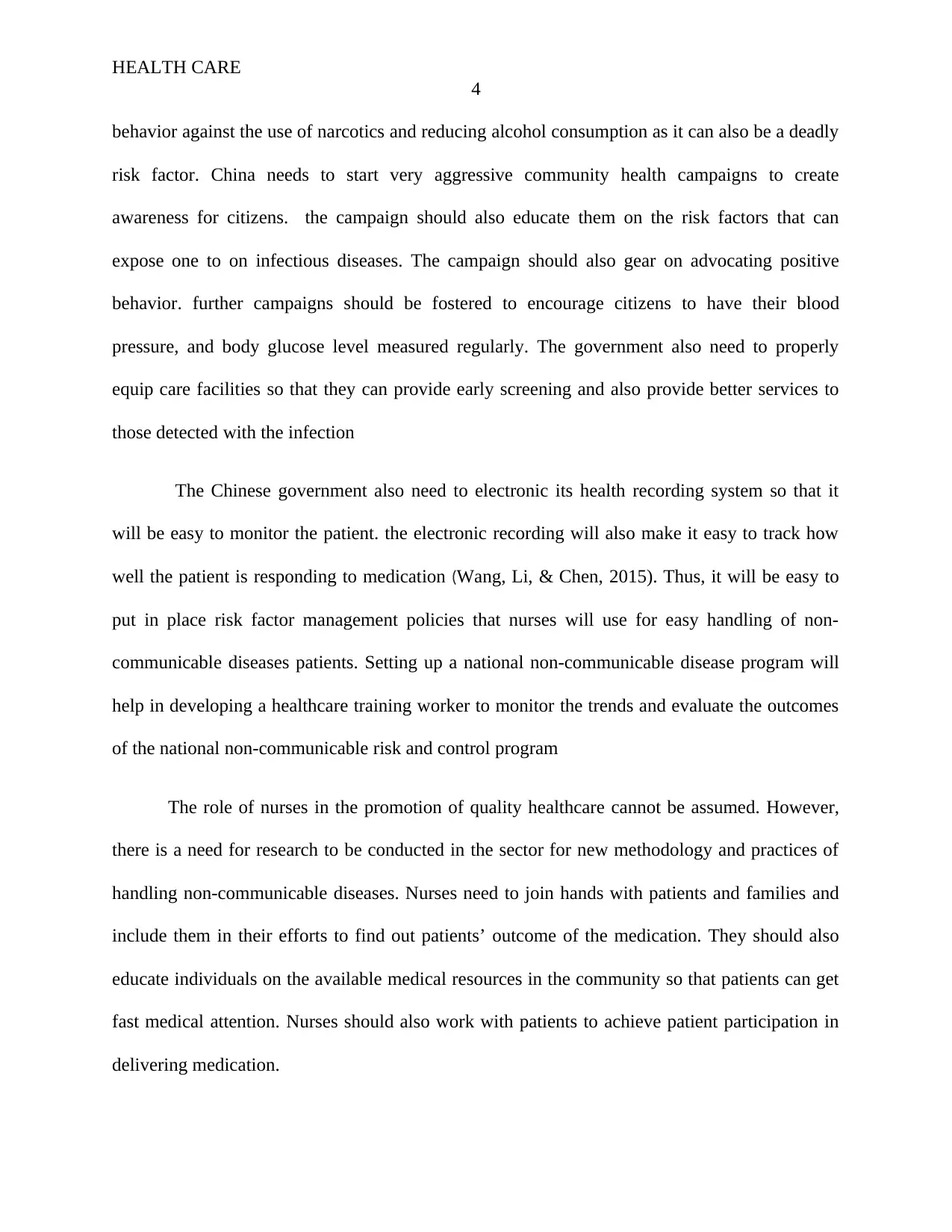
HEALTH CARE
4
behavior against the use of narcotics and reducing alcohol consumption as it can also be a deadly
risk factor. China needs to start very aggressive community health campaigns to create
awareness for citizens. the campaign should also educate them on the risk factors that can
expose one to on infectious diseases. The campaign should also gear on advocating positive
behavior. further campaigns should be fostered to encourage citizens to have their blood
pressure, and body glucose level measured regularly. The government also need to properly
equip care facilities so that they can provide early screening and also provide better services to
those detected with the infection
The Chinese government also need to electronic its health recording system so that it
will be easy to monitor the patient. the electronic recording will also make it easy to track how
well the patient is responding to medication (Wang, Li, & Chen, 2015). Thus, it will be easy to
put in place risk factor management policies that nurses will use for easy handling of non-
communicable diseases patients. Setting up a national non-communicable disease program will
help in developing a healthcare training worker to monitor the trends and evaluate the outcomes
of the national non-communicable risk and control program
The role of nurses in the promotion of quality healthcare cannot be assumed. However,
there is a need for research to be conducted in the sector for new methodology and practices of
handling non-communicable diseases. Nurses need to join hands with patients and families and
include them in their efforts to find out patients’ outcome of the medication. They should also
educate individuals on the available medical resources in the community so that patients can get
fast medical attention. Nurses should also work with patients to achieve patient participation in
delivering medication.
4
behavior against the use of narcotics and reducing alcohol consumption as it can also be a deadly
risk factor. China needs to start very aggressive community health campaigns to create
awareness for citizens. the campaign should also educate them on the risk factors that can
expose one to on infectious diseases. The campaign should also gear on advocating positive
behavior. further campaigns should be fostered to encourage citizens to have their blood
pressure, and body glucose level measured regularly. The government also need to properly
equip care facilities so that they can provide early screening and also provide better services to
those detected with the infection
The Chinese government also need to electronic its health recording system so that it
will be easy to monitor the patient. the electronic recording will also make it easy to track how
well the patient is responding to medication (Wang, Li, & Chen, 2015). Thus, it will be easy to
put in place risk factor management policies that nurses will use for easy handling of non-
communicable diseases patients. Setting up a national non-communicable disease program will
help in developing a healthcare training worker to monitor the trends and evaluate the outcomes
of the national non-communicable risk and control program
The role of nurses in the promotion of quality healthcare cannot be assumed. However,
there is a need for research to be conducted in the sector for new methodology and practices of
handling non-communicable diseases. Nurses need to join hands with patients and families and
include them in their efforts to find out patients’ outcome of the medication. They should also
educate individuals on the available medical resources in the community so that patients can get
fast medical attention. Nurses should also work with patients to achieve patient participation in
delivering medication.
Secure Best Marks with AI Grader
Need help grading? Try our AI Grader for instant feedback on your assignments.
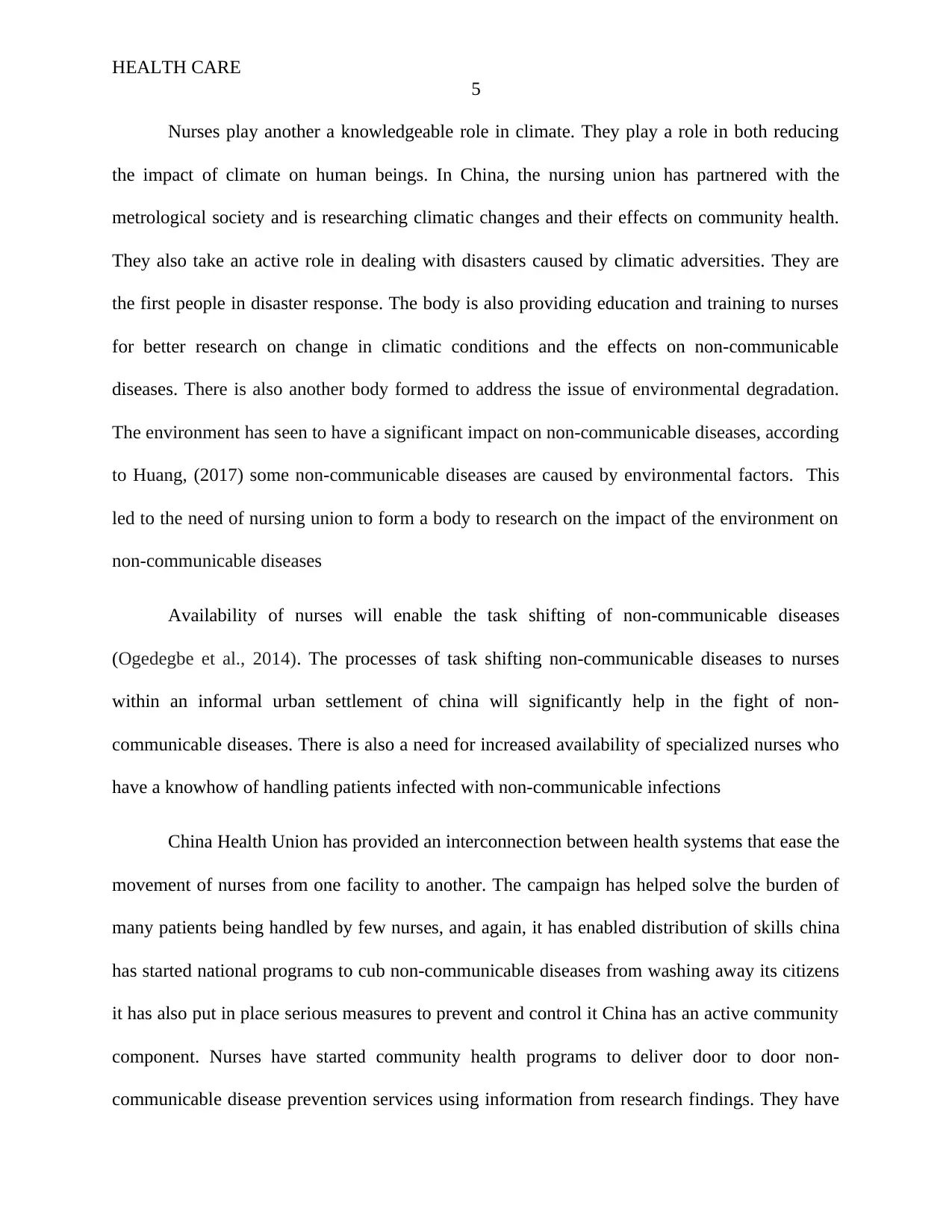
HEALTH CARE
5
Nurses play another a knowledgeable role in climate. They play a role in both reducing
the impact of climate on human beings. In China, the nursing union has partnered with the
metrological society and is researching climatic changes and their effects on community health.
They also take an active role in dealing with disasters caused by climatic adversities. They are
the first people in disaster response. The body is also providing education and training to nurses
for better research on change in climatic conditions and the effects on non-communicable
diseases. There is also another body formed to address the issue of environmental degradation.
The environment has seen to have a significant impact on non-communicable diseases, according
to Huang, (2017) some non-communicable diseases are caused by environmental factors. This
led to the need of nursing union to form a body to research on the impact of the environment on
non-communicable diseases
Availability of nurses will enable the task shifting of non-communicable diseases
(Ogedegbe et al., 2014). The processes of task shifting non-communicable diseases to nurses
within an informal urban settlement of china will significantly help in the fight of non-
communicable diseases. There is also a need for increased availability of specialized nurses who
have a knowhow of handling patients infected with non-communicable infections
China Health Union has provided an interconnection between health systems that ease the
movement of nurses from one facility to another. The campaign has helped solve the burden of
many patients being handled by few nurses, and again, it has enabled distribution of skills china
has started national programs to cub non-communicable diseases from washing away its citizens
it has also put in place serious measures to prevent and control it China has an active community
component. Nurses have started community health programs to deliver door to door non-
communicable disease prevention services using information from research findings. They have
5
Nurses play another a knowledgeable role in climate. They play a role in both reducing
the impact of climate on human beings. In China, the nursing union has partnered with the
metrological society and is researching climatic changes and their effects on community health.
They also take an active role in dealing with disasters caused by climatic adversities. They are
the first people in disaster response. The body is also providing education and training to nurses
for better research on change in climatic conditions and the effects on non-communicable
diseases. There is also another body formed to address the issue of environmental degradation.
The environment has seen to have a significant impact on non-communicable diseases, according
to Huang, (2017) some non-communicable diseases are caused by environmental factors. This
led to the need of nursing union to form a body to research on the impact of the environment on
non-communicable diseases
Availability of nurses will enable the task shifting of non-communicable diseases
(Ogedegbe et al., 2014). The processes of task shifting non-communicable diseases to nurses
within an informal urban settlement of china will significantly help in the fight of non-
communicable diseases. There is also a need for increased availability of specialized nurses who
have a knowhow of handling patients infected with non-communicable infections
China Health Union has provided an interconnection between health systems that ease the
movement of nurses from one facility to another. The campaign has helped solve the burden of
many patients being handled by few nurses, and again, it has enabled distribution of skills china
has started national programs to cub non-communicable diseases from washing away its citizens
it has also put in place serious measures to prevent and control it China has an active community
component. Nurses have started community health programs to deliver door to door non-
communicable disease prevention services using information from research findings. They have
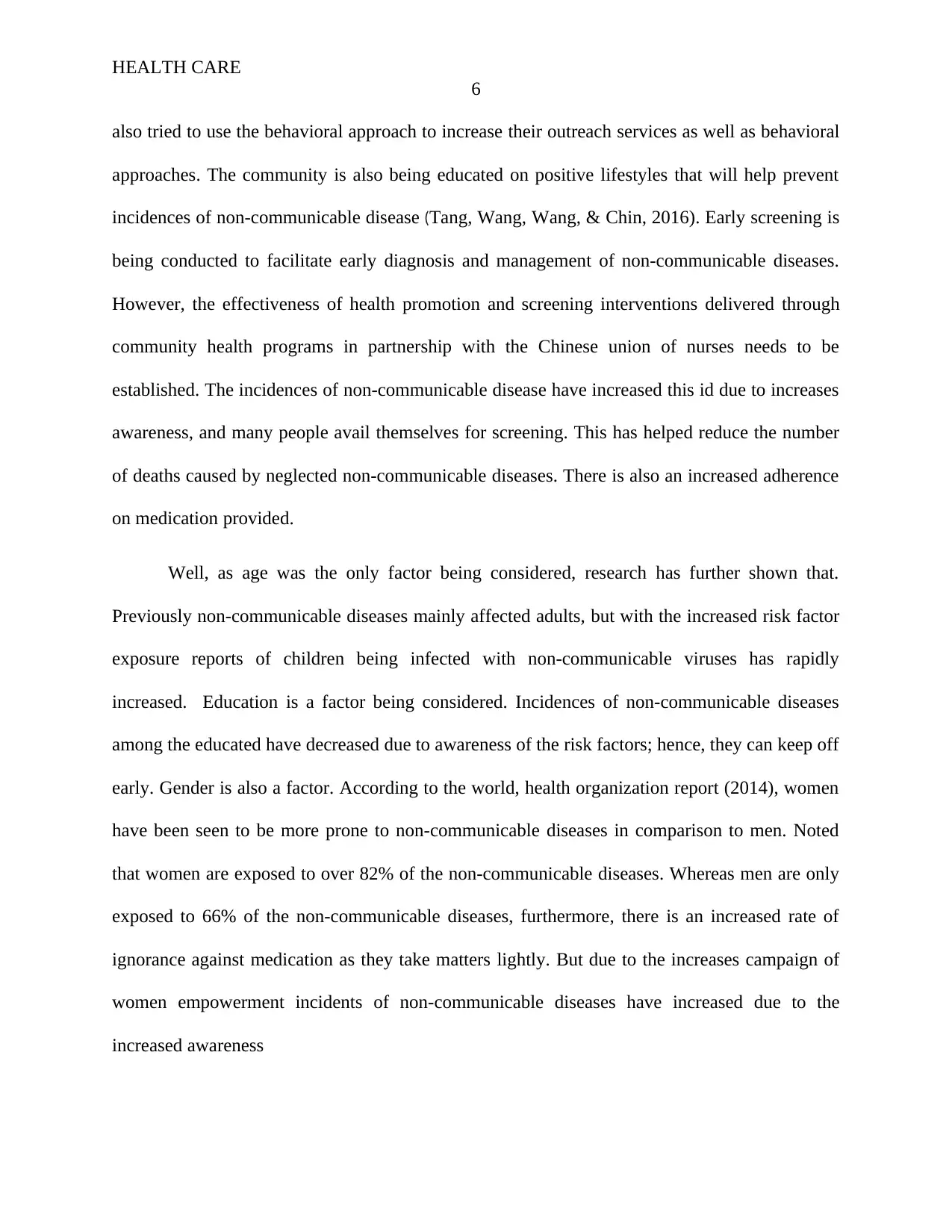
HEALTH CARE
6
also tried to use the behavioral approach to increase their outreach services as well as behavioral
approaches. The community is also being educated on positive lifestyles that will help prevent
incidences of non-communicable disease (Tang, Wang, Wang, & Chin, 2016). Early screening is
being conducted to facilitate early diagnosis and management of non-communicable diseases.
However, the effectiveness of health promotion and screening interventions delivered through
community health programs in partnership with the Chinese union of nurses needs to be
established. The incidences of non-communicable disease have increased this id due to increases
awareness, and many people avail themselves for screening. This has helped reduce the number
of deaths caused by neglected non-communicable diseases. There is also an increased adherence
on medication provided.
Well, as age was the only factor being considered, research has further shown that.
Previously non-communicable diseases mainly affected adults, but with the increased risk factor
exposure reports of children being infected with non-communicable viruses has rapidly
increased. Education is a factor being considered. Incidences of non-communicable diseases
among the educated have decreased due to awareness of the risk factors; hence, they can keep off
early. Gender is also a factor. According to the world, health organization report (2014), women
have been seen to be more prone to non-communicable diseases in comparison to men. Noted
that women are exposed to over 82% of the non-communicable diseases. Whereas men are only
exposed to 66% of the non-communicable diseases, furthermore, there is an increased rate of
ignorance against medication as they take matters lightly. But due to the increases campaign of
women empowerment incidents of non-communicable diseases have increased due to the
increased awareness
6
also tried to use the behavioral approach to increase their outreach services as well as behavioral
approaches. The community is also being educated on positive lifestyles that will help prevent
incidences of non-communicable disease (Tang, Wang, Wang, & Chin, 2016). Early screening is
being conducted to facilitate early diagnosis and management of non-communicable diseases.
However, the effectiveness of health promotion and screening interventions delivered through
community health programs in partnership with the Chinese union of nurses needs to be
established. The incidences of non-communicable disease have increased this id due to increases
awareness, and many people avail themselves for screening. This has helped reduce the number
of deaths caused by neglected non-communicable diseases. There is also an increased adherence
on medication provided.
Well, as age was the only factor being considered, research has further shown that.
Previously non-communicable diseases mainly affected adults, but with the increased risk factor
exposure reports of children being infected with non-communicable viruses has rapidly
increased. Education is a factor being considered. Incidences of non-communicable diseases
among the educated have decreased due to awareness of the risk factors; hence, they can keep off
early. Gender is also a factor. According to the world, health organization report (2014), women
have been seen to be more prone to non-communicable diseases in comparison to men. Noted
that women are exposed to over 82% of the non-communicable diseases. Whereas men are only
exposed to 66% of the non-communicable diseases, furthermore, there is an increased rate of
ignorance against medication as they take matters lightly. But due to the increases campaign of
women empowerment incidents of non-communicable diseases have increased due to the
increased awareness
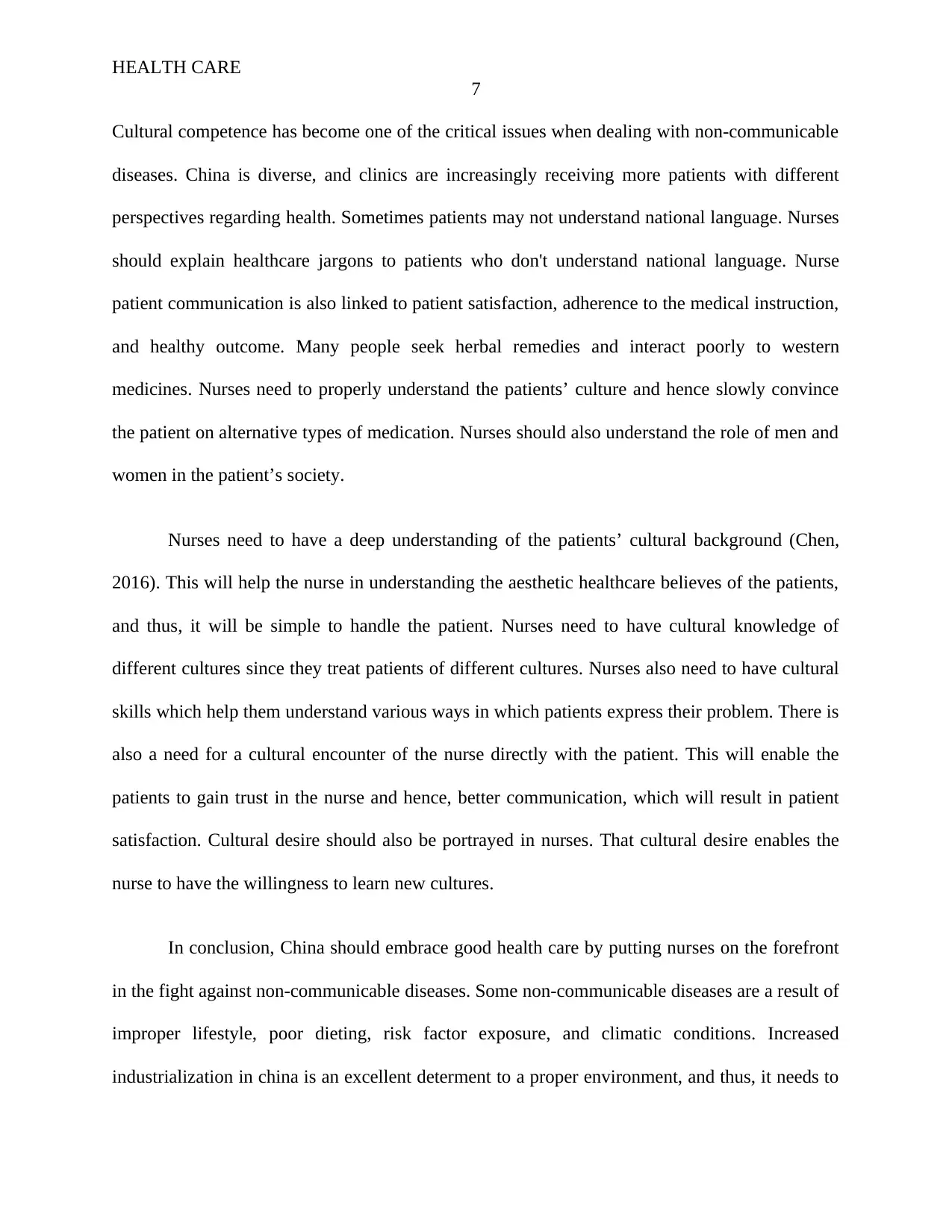
HEALTH CARE
7
Cultural competence has become one of the critical issues when dealing with non-communicable
diseases. China is diverse, and clinics are increasingly receiving more patients with different
perspectives regarding health. Sometimes patients may not understand national language. Nurses
should explain healthcare jargons to patients who don't understand national language. Nurse
patient communication is also linked to patient satisfaction, adherence to the medical instruction,
and healthy outcome. Many people seek herbal remedies and interact poorly to western
medicines. Nurses need to properly understand the patients’ culture and hence slowly convince
the patient on alternative types of medication. Nurses should also understand the role of men and
women in the patient’s society.
Nurses need to have a deep understanding of the patients’ cultural background (Chen,
2016). This will help the nurse in understanding the aesthetic healthcare believes of the patients,
and thus, it will be simple to handle the patient. Nurses need to have cultural knowledge of
different cultures since they treat patients of different cultures. Nurses also need to have cultural
skills which help them understand various ways in which patients express their problem. There is
also a need for a cultural encounter of the nurse directly with the patient. This will enable the
patients to gain trust in the nurse and hence, better communication, which will result in patient
satisfaction. Cultural desire should also be portrayed in nurses. That cultural desire enables the
nurse to have the willingness to learn new cultures.
In conclusion, China should embrace good health care by putting nurses on the forefront
in the fight against non-communicable diseases. Some non-communicable diseases are a result of
improper lifestyle, poor dieting, risk factor exposure, and climatic conditions. Increased
industrialization in china is an excellent determent to a proper environment, and thus, it needs to
7
Cultural competence has become one of the critical issues when dealing with non-communicable
diseases. China is diverse, and clinics are increasingly receiving more patients with different
perspectives regarding health. Sometimes patients may not understand national language. Nurses
should explain healthcare jargons to patients who don't understand national language. Nurse
patient communication is also linked to patient satisfaction, adherence to the medical instruction,
and healthy outcome. Many people seek herbal remedies and interact poorly to western
medicines. Nurses need to properly understand the patients’ culture and hence slowly convince
the patient on alternative types of medication. Nurses should also understand the role of men and
women in the patient’s society.
Nurses need to have a deep understanding of the patients’ cultural background (Chen,
2016). This will help the nurse in understanding the aesthetic healthcare believes of the patients,
and thus, it will be simple to handle the patient. Nurses need to have cultural knowledge of
different cultures since they treat patients of different cultures. Nurses also need to have cultural
skills which help them understand various ways in which patients express their problem. There is
also a need for a cultural encounter of the nurse directly with the patient. This will enable the
patients to gain trust in the nurse and hence, better communication, which will result in patient
satisfaction. Cultural desire should also be portrayed in nurses. That cultural desire enables the
nurse to have the willingness to learn new cultures.
In conclusion, China should embrace good health care by putting nurses on the forefront
in the fight against non-communicable diseases. Some non-communicable diseases are a result of
improper lifestyle, poor dieting, risk factor exposure, and climatic conditions. Increased
industrialization in china is an excellent determent to a proper environment, and thus, it needs to
Paraphrase This Document
Need a fresh take? Get an instant paraphrase of this document with our AI Paraphraser

HEALTH CARE
8
address with immediate effect. The government should also take account of the epidemiological
study that was conducted by the health research organization as it will act as a stair to proper
healthcare realization. Lastly, cultural competence should be embraced by nurses as it will help
to achieve patient satisfaction and promote good healthcare.
8
address with immediate effect. The government should also take account of the epidemiological
study that was conducted by the health research organization as it will act as a stair to proper
healthcare realization. Lastly, cultural competence should be embraced by nurses as it will help
to achieve patient satisfaction and promote good healthcare.
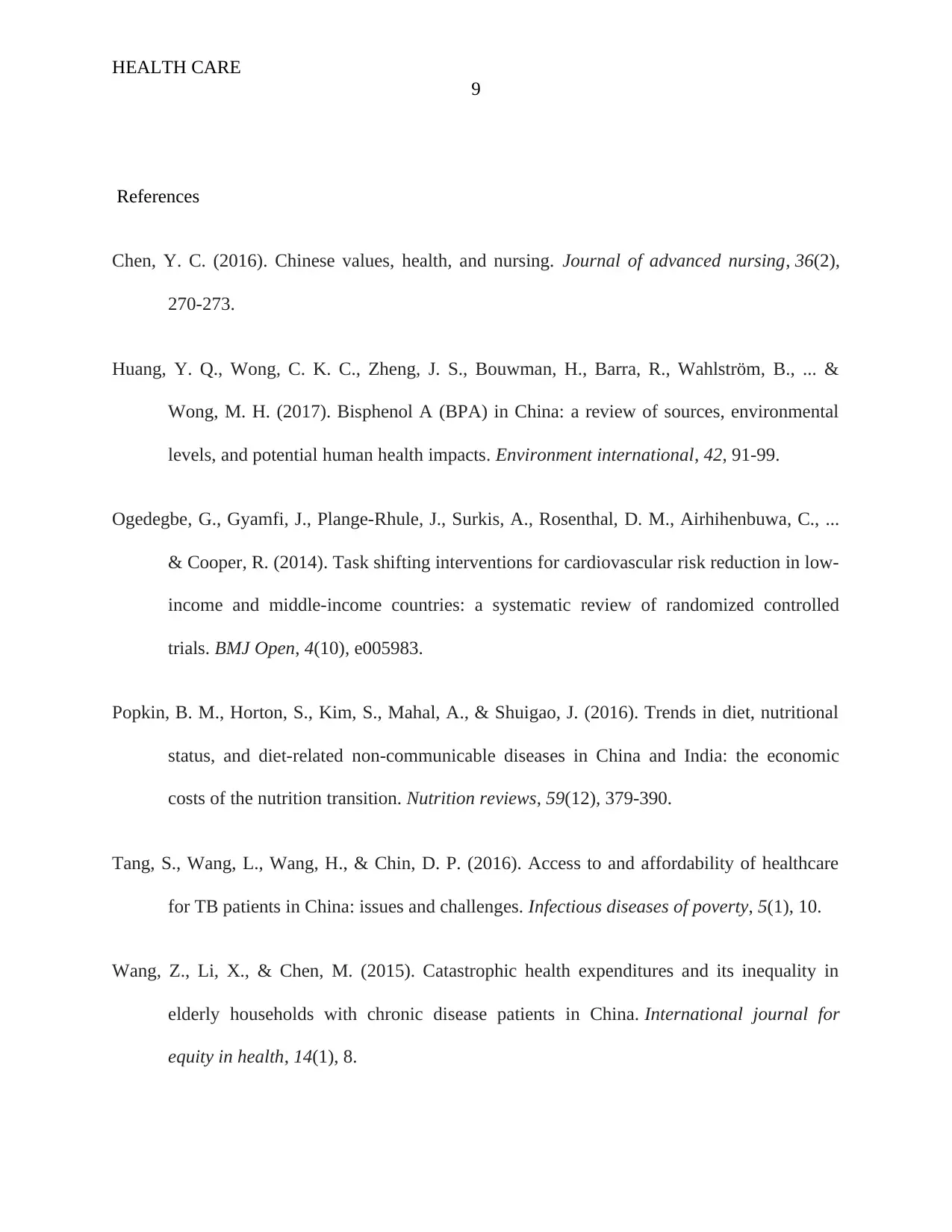
HEALTH CARE
9
References
Chen, Y. C. (2016). Chinese values, health, and nursing. Journal of advanced nursing, 36(2),
270-273.
Huang, Y. Q., Wong, C. K. C., Zheng, J. S., Bouwman, H., Barra, R., Wahlström, B., ... &
Wong, M. H. (2017). Bisphenol A (BPA) in China: a review of sources, environmental
levels, and potential human health impacts. Environment international, 42, 91-99.
Ogedegbe, G., Gyamfi, J., Plange-Rhule, J., Surkis, A., Rosenthal, D. M., Airhihenbuwa, C., ...
& Cooper, R. (2014). Task shifting interventions for cardiovascular risk reduction in low-
income and middle-income countries: a systematic review of randomized controlled
trials. BMJ Open, 4(10), e005983.
Popkin, B. M., Horton, S., Kim, S., Mahal, A., & Shuigao, J. (2016). Trends in diet, nutritional
status, and diet-related non-communicable diseases in China and India: the economic
costs of the nutrition transition. Nutrition reviews, 59(12), 379-390.
Tang, S., Wang, L., Wang, H., & Chin, D. P. (2016). Access to and affordability of healthcare
for TB patients in China: issues and challenges. Infectious diseases of poverty, 5(1), 10.
Wang, Z., Li, X., & Chen, M. (2015). Catastrophic health expenditures and its inequality in
elderly households with chronic disease patients in China. International journal for
equity in health, 14(1), 8.
9
References
Chen, Y. C. (2016). Chinese values, health, and nursing. Journal of advanced nursing, 36(2),
270-273.
Huang, Y. Q., Wong, C. K. C., Zheng, J. S., Bouwman, H., Barra, R., Wahlström, B., ... &
Wong, M. H. (2017). Bisphenol A (BPA) in China: a review of sources, environmental
levels, and potential human health impacts. Environment international, 42, 91-99.
Ogedegbe, G., Gyamfi, J., Plange-Rhule, J., Surkis, A., Rosenthal, D. M., Airhihenbuwa, C., ...
& Cooper, R. (2014). Task shifting interventions for cardiovascular risk reduction in low-
income and middle-income countries: a systematic review of randomized controlled
trials. BMJ Open, 4(10), e005983.
Popkin, B. M., Horton, S., Kim, S., Mahal, A., & Shuigao, J. (2016). Trends in diet, nutritional
status, and diet-related non-communicable diseases in China and India: the economic
costs of the nutrition transition. Nutrition reviews, 59(12), 379-390.
Tang, S., Wang, L., Wang, H., & Chin, D. P. (2016). Access to and affordability of healthcare
for TB patients in China: issues and challenges. Infectious diseases of poverty, 5(1), 10.
Wang, Z., Li, X., & Chen, M. (2015). Catastrophic health expenditures and its inequality in
elderly households with chronic disease patients in China. International journal for
equity in health, 14(1), 8.

HEALTH CARE
10
World Health Organization, the World Health Organization. Ageing & Life Course Unit. (2014).
WHO global report on falls prevention in older age. World Health Organization.
10
World Health Organization, the World Health Organization. Ageing & Life Course Unit. (2014).
WHO global report on falls prevention in older age. World Health Organization.
1 out of 10
Related Documents
Your All-in-One AI-Powered Toolkit for Academic Success.
+13062052269
info@desklib.com
Available 24*7 on WhatsApp / Email
![[object Object]](/_next/static/media/star-bottom.7253800d.svg)
Unlock your academic potential
© 2024 | Zucol Services PVT LTD | All rights reserved.





